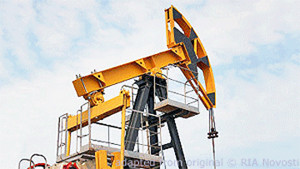Money Is Flooding Into Russia Despite Crashing Oil Prices

(Oilprice.com – Michael Kern – April 7, 2020)
With the virtual OPEC+ meeting where Russia and Saudi Arabia were to discuss output cuts to end the oil price war delayed Monday, oil prices took a huge beating–but Russian stocks are still hanging on. While state-backed companies saw their share prices shredded on March 9th, including major banks Sberbank and VTB as well as energy giants Rosneft and Gazprom, shedding billions, the market is still being relatively kind to them, all things considered.
On March 6th, Sberbank was trading on the LSE at $12.94 per share. By close on Monday, it was trading at $9.94. That’s not exactly the crash that many expected.
And when it comes to the top three Russian oil companies, Rosneft, Gazprom, and Lukoil, we’re not seeing a major share disaster at all.
Since the second week of March, Rosneft has regained most of what it had lost:
And Gazprom is largely unscathed, if not reveling in the crisis:
On March 19th, the Moscow Exchange (MOEX) hit a one-year low as global investors fled assets made risky by the oil price war and COVID-19 fears.
Yet, according to Reuters, things have changed since then; retail investors are now flooding into the Moscow market, with Gazprom winning the popularity contest. Gazprom shares were included in 23.6% of portfolios.
And today, despite the postponement of the virtual OPEC+ meeting featuring Russia and Saudi Arabia, Russia’s stock markets still managed to book early gains.
This is not the ideal situation for forcing Russia back to the oil debate table.
In fact, the only potential silver lining right now is that Russia’s oil production already dropped in the first week in April simply because it makes no sense for its oil companies to produce more when the market is already so oversupplied and storage space severely curtailed.
Reuters reported on Monday that Russian oil production is down about 0.35% so far in April, compared to its average output in March.
Tariffs Won’t Make Russia Back Down
This is partly a diplomatic war at this point. That means it’s about saving face for all involved. The Saudis have already saved face by making it clear that this is a Russian attack on U.S. shale. But the Saudi attack on Putin is what got the virtual meeting canceled in the first place.
Throughout this game, it has been imperative for the Saudis that the United States put the blame for the oil price war squarely on Russia, noting that the Saudis have no desire to decimate the U.S. shale patch and pointing to the Kingdom’s major investments in the U.S. oil sector.
But it’s also an existential war: With the coronavirus crushing global demand, and with Russian producers already starting to produce less simply because nothing else makes sense, an OPEC++ deal may mean nothing at all.
Indeed, James Henderson of the Oxford Institute for Energy Studies told the Energy Voice: “There is a genuine reluctance in Russia to cut production. The feeling is that, at this point, such a move would be meaningless given uncertainty over demand.”
Regardless, Russia has less to lose, and the U.S. shale patch was the key beneficiary of OPEC+ cuts that preceded the latest combination of crises.
Why does Russia have less to lose? Its oil companies are profitable at $30 oil. Their currency is free-floating. The Russian budget is stable for years out, with a strategy that has seen Moscow boost foreign currency reserves nicely. The ruble is holding steady, despite a bit of temporary panic in March.
So, where does this leave Russia’s biggest stocks?
Sitting rather prettily.
When Russian markets opened on April 6th, everything was green. The RTS Index opened 2.2% higher, and the MOEX opened 0.9% higher.
But Russia isn’t entirely in the clear, even if it’s all worth it.
Despite its ability to theoretically survive at $30 oil, indefinitely if you hear Russia tell it, it still will have a hard time finding buyers for its crude oil with Saudi Arabia flooding the market. And sooner or later, storage will max.
Additionally, the market is already pricing in production cuts that haven’t been agreed upon, and if those fail to happen, Russia’s biggest stocks–including the oil giants–will take a hit along with everyone else.
The bottom line: The Russian markets are trading on the economic hit the U.S. will take over the coronavirus. And that’s where everyone’s hedging their bets. Russia has far more to gain by not negotiating at this point. Its gain is in America’s loss, and whatever hit it takes in the meantime is worth it. The markets would seem to agree.
[Article also appeared at oilprice.com/Energy/Energy-General/Money-Is-Flooding-Into-Russia-Despite-Crashing-Oil-Prices.html]
